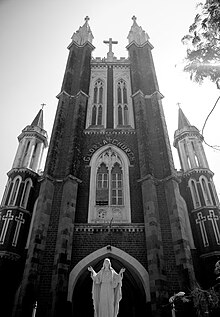Gloria Church
| Gloria Church Nossa Senhora de Gloria | |
|---|---|
 | |
| Religion | |
| Affiliation | Roman Catholic |
| Rite | Latin |
| Ecclesiastical or organizational status | Active |
| Year consecrated | original structure 1632 |
| Location | |
| Location | |
| Geographic coordinates | 18°58′30″N 72°50′03″E / 18.975°N 72.834167°E |
| Architecture | |
| Style | English Gothic Revival |
| Completed | 1913 |
| Minaret(s) | 4 |
Gloria Church or Our Lady of Glory Church (Portuguese: Nossa Senhora de Gloria) is built in 1911-13 on one of the oldest Roman Catholic church sites in Mumbai; its predecessor was built by the Portuguese Franciscans in 1632. The church is situated in Byculla, Mumbai.[1] In 2019, the restoration project for the church received the Award of Merit under the UNESCO Asia-Pacific Awards for Cultural Heritage Conservation.[2]
History
The original Gloria Church, Nossa Senhora da Glória, was built in 1632 at the foot of the Mazagaon hill. This Franciscan church was funded by the De Souza e Lima family, who owned the Mazagaon island which they procured from the King of Portugal in 1572. The old church was demolished in 1911 and the present one, built at Byculla,[1] was opened in 1913.[3]
Architecture
The modern Gloria church was built in English Gothic Revival style.[4]
Popular culture
The church’s beauty has inspired many filmmakers to shoot their films on its premises.[citation needed] Prominent among them was Manmohan Desai’s Amar Akbar Anthony, released in 1977.[citation needed]
References
- ^ a b "Glorious past". Express India. 28 October 2008. Archived from the original on 5 February 2008. Retrieved 17 June 2009.
- ^ https://www.thehindu.com/news/cities/mumbai/mumbai-monuments-win-big-at-unesco-restoration-awards/article29685175.ece
- ^ Gillian Tindall (1992). City of Gold: The Biography of Bombay. Penguin Books India. pp. 38–. ISBN 978-0-14-009500-5.
- ^ The church at the gateway of India, 1720-1960 By James H. Gense, p. 373
